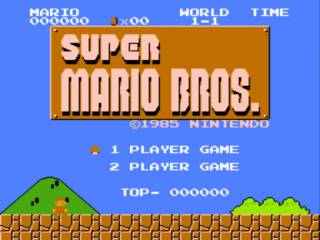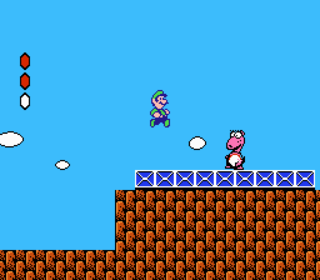Navigation
Sub-franchises:
Super Mario Bros. | Super Mario Land | Super Mario World | Super Mario Advance | Super Mario Galaxy | New Super Mario Bros.
Super Mario Bros.
 SMB Title Screen
SMB Title ScreenSuper Mario Bros. was a platform game released on September 13, 1985 in Japan, October 18, 1985 in North America, May 15, 1987 in Europe and 1987 in Australia. Sequel to Mario Bros, Players take the role of Mario (or Luigi in two-player mode) and must save Princess Toadstool (later known as Princess Peach) of the Mushroom Kingdom from the evil King Koopa (later known as Bowser). To save Princess Toadstool, players must complete the eight worlds that encompass the Mushroom Kingdom. Super Mario Bros. is the best selling video game of all time with over 40 million copies sold as of 2008.
Super Mario Bros. has had many other versions. All Night Nippon Super Mario Bros. was a version released only in Japan that was based on the popular Japanese TV show All Night Nippon. A version of the game called Super Mario Bros. Special was also released on the NEC PC-8801, and had minor differences. Vs. Super Mario Bros. was a version of the game released only in arcades that was based on Super Mario Bros. It had many differences in stages and various other things. Super Mario Bros. was packaged with Duck Hunt and World Class Track Meet. A version of Super Mario Bros. was also released on the Game Boy Advance in the Classic NES Series.
Super Mario Bros. 2
 Super Mario Bros. 2
Super Mario Bros. 2Super Mario Bros. 2 was released in North America on October 10, 1988, April 28 1989 in Europe, May 1989 in Australia and July 14, 1992 in Japan. Not a Mario title originally, it was supposed to be a remake of the Japanese title Yume Kojo: Doki Doki Panic. A true sequel to Super Mario Bros. was released in Japan in 1986 under the name, Super Mario Bros. 2. Due to the game's extreme difficulty and similarity to the original game, Nintendo decided not to release it elsewhere for the time being. Instead, Nintendo released Doki Doki Panic with Mario characters under the Super Mario Bros. 2 name in the West. The western version was later released in Japan under the title, Super Mario USA. The Japanese version was released to the rest of the world as Super Mario Bros.: The Lost Levels, and was part of the Super Mario All-Stars collection for the SNES.
Super Mario Bros. 3
 Super Mario Bros. 3
Super Mario Bros. 3Super Mario Bros. 3 was released on October 23, 1988 in Japan, February 12, 1990 in North America and August 29, 1991 in Europe. Originally planned for a 1989 release in North America, it was held back one year due to Nintendo claiming a chip shortage, used in producing cartridges. While the Western version of Super Mario Bros. 2 felt entirely different, Super Mario Bros. 3 is much more like the original Super Mario Bros. with many advancements, including mini-games, new power-ups, levels and enemies. Mario and Luigi are to rescue the seven kings of the seven worlds neighboring the Mushroom Kingdom. The magic wand that each king once possessed have been stolen by one of the Koopa Kids, and has turned each king into a type of animal.
Super Mario Land
 Super Mario Land
Super Mario LandSuper Mario Land was released on April 21, 1989 in Japan, August 1, 1989 in North America and September 28, 1990 in Europe. The game was Mario's first appearance on the Game Boy. It was a launch title for the Game Boy for both Japan and North America. The game went on to sell over 18 million copies. Super Mario Land takes place in the land of Sarasaland, split into four different kingdoms. A mysterious alien appears, hypnotizes the inhabitants, and kidnaps Princess Daisy to marry her. Mario travels through the four different areas of Sarasaland in order to save her.
Super Mario World
 Super Mario World
Super Mario WorldSuper Mario World was released on November 21, 1990 in Japan, August 13, 1991 in North America and June 4, 1992 in Europe. It was a pack-in launch title for the Super Nintendo, and became the best seller for the system with over 20 million copies sold. Once again Mario much travel through various lands in order to rescue Princess Toadstool, who was kidnapped by Bowser. In Japan, Super Mario World was also known as Super Mario Bros. 4.
Super Mario Land 2: 6 Golden Coins
 Super Mario Land 2: 6 Golden Coins
Super Mario Land 2: 6 Golden CoinsSuper Mario Land 2: 6 Golden Coins was released on October 21, 1992 in Japan, November 1, 1992 in North America and January 28, 1993 in Europe. The game follows right after the original Super Mario Land. While Mario was away at Sarasaland, Wario cast an evil spell on the Mushroom Kingdom and renamed it to Wario Land. The residents are brainwashed into believing that Wario is their master while Mario is their enemy. Wario's intention behind this is to seize control of Mario's castle to have a palace of his own. To stop Wario, Mario is required to find 6 Golden Coins to gain access to his castle. It was the first game to feature Wario.
Super Mario Bros. 2: The Lost Levels
 Super Mario Bros. 2: The Lost Levels
Super Mario Bros. 2: The Lost LevelsThe true sequel to Super Mario Bros., it was released in Japan in 1986 under the name, Super Mario Bros. 2. Due to the game's extreme difficulty and similarity to the original game, Nintendo decided not to release it elsewhere for the time being. These levels were eventually released to the rest of the world as Super Mario Bros.: The Lost Levels, and was part of the Super Mario All-Stars collection for the SNES. It does not support a two-player mode, but players can play as either Mario or Luigi to travel through the Mushroom Kingdom and save Princess Toadstool.
Super Mario All-Stars
 Super Mario All-Stars
Super Mario All-StarsSuper Mario All-Stars was an enhanced remake of the first four Mario games: Super Mario Bros, Super Mario. Bros: The Lost Levels, Super Mario Bros. 2, and Super Mario Bros. 3. It features graphical enhancements, glitch fixes and the ability to save, no longer requiring players to start from the beginning if they lose all their lives. An alternate version that included Super Mario World, known as Super Mario All-Stars Super Mario World, was bundled with the Super Nintendo in December 1994.
Super Mario 64
 Super Mario 64
Super Mario 64Super Mario 64 was released on June 23, 1996 in Japan, September 26, 1996 in North America, March 1, 1997 in PAL territories, and June 1997 in Australia. It was one of the Nintendo 64's launch titles. It was the second Mario game to be in three dimensions.
Super Mario Bros. Deluxe
 Super Mario Bros. Deluxe
Super Mario Bros. DeluxeSuper Mario Bros. Deluxe was released on the Game Boy Color in 1999, the game plays basically the same as Super Mario Bros. with simultaneous multiplayer, a Challenge mode and Super Mario Bros. The Lost Levels included as an unlockable.
Super Mario Advance
 Super Mario Advance
Super Mario AdvanceSuper Mario Advance was an enhanced remake of Super Mario Bros. 2, it was the first Mario title for the Game Boy Advance. Several graphic and sound enhancements were included. Two new additions include a new character, Robirdo, and the Yoshi challenge, motivating players to revisit areas to collect Yoshi eggs.
Super Mario World: Super Mario Advance 2
 Super Mario World: Super Mario Advance 2
Super Mario World: Super Mario Advance 2Super Mario World: Super Mario Advance 2 was a port of Super Mario World for the Game Boy Advance in 2002. This version adds a few new features such as Peach Coins as well gameplay differences between Mario and Luigi and a new sprite set for Luigi.
Super Mario Sunshine
 Super Mario Sunshine
Super Mario SunshineSuper Mario Sunshine was released on July 19, 2002 in Japan, August 26, 2002 in North America and October 4, 2002 in Europe. It was the second 3D Mario platformer. The setting for the game is on the tropical Isle Delfino. Both Mario and Princess Peach are taking a vacation. A villain bearing resemblance to Mario vandalizes the island with graffiti, and Mario gets blamed for it. Mario has to clean up Isle Delfino and save Princess Peach from the impostor.
Super Mario Bros. 3: Super Mario Advance 4
 Super Mario Bros. 3: Super Mario Advance 4
Super Mario Bros. 3: Super Mario Advance 4Super Mario Bros. 3: Super Mario Advance 4 was similar to Super Mario Bros. 3, it includes the updated original Mario Bros. as well as the ability to connect via the link cable for multi-player battles. It supports the Game Boy Advance's e-Reader device, allowing players to scan e-Cards.
Super Mario 64 DS
 Super Mario 64 DS
Super Mario 64 DSSuper Mario 64 DS was released on November 21, 2004 in North America, December 2, 2004 in Japan, February 24, 2005 in Australia and March 11, 2005 in Europe. It is an enhanced remake of Super Mario 64 which adds new characters, different modes of play, mini-games, new levels and updated graphics.
New Super Mario Bros.
 New Super Mario Bros.
New Super Mario Bros.New Super Mario Bros. was released on May 15, 2006 in North America, May 25, 2006 in Japan, June 8, 2006 in Australia, and June 20, 2006 in Europe. It is the first original side-scroller starring Mario since Super Mario Land 2. Bowser Jr. captures Princess Peach and Mario must rescue her. It has eight worlds consisting of 80 levels total.
Super Mario Galaxy
 Super Mario Galaxy
Super Mario GalaxySuper Mario Galaxy was released on November 1, 2007 in Japan, November 12, 2007 in North America, November 14, 2007 in Canada, November 16, 2007 in Europe and November 29, 2007 in Australia. Mario must save Princess Peach from Bowser by traversing through outer space and collecting Power Stars in various galaxies.
New Super Mario Bros. Wii
 The title screen for New Super Mario Bros. Wii
The title screen for New Super Mario Bros. WiiAnnounced at E3 2009, New Super Mario Bros. Wii is a 2-D side scrolling game with 3-D graphics. It can be played with up to four players cooperatively. Players one and two will play as Mario and Luigi repesctively, and players three and four will play as two new Toads, Yvan and Wolley respectively. The players can join or leave at any time. The game features new power-ups such as a Penguin Suit. The game is set to release in Q4 2009.
Super Mario Galaxy 2
 Super Mario Galaxy 2
Super Mario Galaxy 2Originally announced at E3 2009, Super Mario Galaxy 2 was released on May 23, 2010 in North America and May 27, 2010 in Japan. It is slated for release in Europe on June 11, 2010 and in Australia on July 1, 2010. It features Mario returning to outer space in a second 3-D Mario game for the Nintendo Wii. (The first time ever that two 3-D Mario games have appeared on a Nintendo console.) It originally started out as a Super Mario Galaxy "1.5," but eventually developed into a full sequel. While reusing several assets from Super Mario Galaxy, the final game is reportedly composed of about 90% new levels and features the return of Yoshi as well as multiple new power-ups such as the Cloud Suit, the Drill Suit, the Dash Pepper, the Blimp Fruit, and the Bulb Berry.
Log in to comment